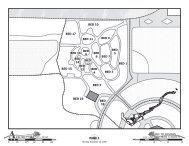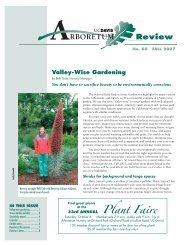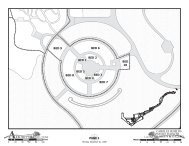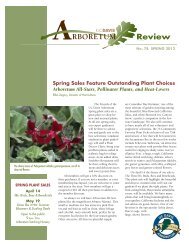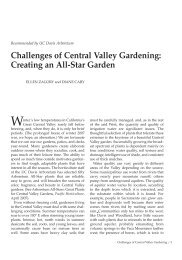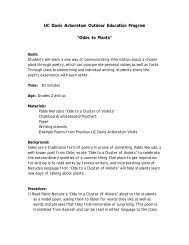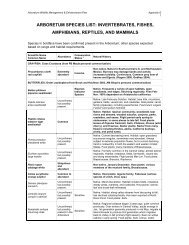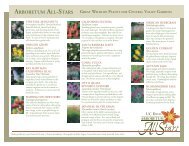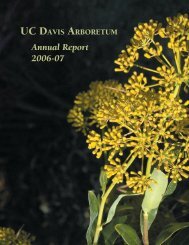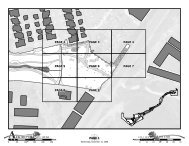Fall 2009 - the UC Davis Arboretum
Fall 2009 - the UC Davis Arboretum
Fall 2009 - the UC Davis Arboretum
You also want an ePaper? Increase the reach of your titles
YUMPU automatically turns print PDFs into web optimized ePapers that Google loves.
Ellen Zagory<br />
Autumn sage, Salvia greggii, an <strong>Arboretum</strong> All-Star, is visited<br />
frequently by hummingbirds and <strong>the</strong> pipevine swallowtail butterfly.<br />
You’ll find several color forms at <strong>Arboretum</strong> sales.<br />
FALL PLANt SALeS<br />
NEW—TWO fall sales this year!<br />
Saturday, October 3<br />
Member sale 9–11 a m<br />
Public sale 11 a m–1 pm<br />
Saturday, Oct. 17<br />
Public sale 9 a m–1 pm<br />
<strong>Arboretum</strong> Teaching Nursery<br />
Review<br />
No. 68 FALL <strong>2009</strong><br />
<strong>Fall</strong> Plant Sales Feature All-Stars,<br />
California Natives, Pollinator Plants<br />
Ellen Zagory, Director of Horticulture and Diane Cary, Communications Director<br />
New demonstration plantings at <strong>the</strong> <strong>Arboretum</strong> Teaching<br />
Nursery make it easy to choose great plants for your<br />
sustainable garden<br />
At <strong>the</strong> fall plant sales<br />
at <strong>the</strong> <strong>Arboretum</strong> Teaching<br />
Nursery, gardeners will see<br />
beautiful new raised planters<br />
showcasing gorgeous<br />
plant combinations and<br />
intriguing garden <strong>the</strong>mes<br />
that gardeners can replicate<br />
in <strong>the</strong>ir own home<br />
landscapes. These demonstration<br />
plantings include<br />
two beds highlighting <strong>the</strong><br />
<strong>Arboretum</strong> All-Star plants,<br />
a habitat planting to support<br />
birds and butterflies, a<br />
garden of California native<br />
plants, and a pollinator<br />
garden meant to attract <strong>the</strong><br />
greatest diversity of pollinating<br />
insects possible in a<br />
small area.<br />
Recently we have heard<br />
a lot about <strong>the</strong> decline of<br />
plant pollinators, such as <strong>the</strong> die-off of European<br />
honeybees from Colony Collapse Disorder,<br />
which threatens crop production in some areas.<br />
In <strong>the</strong> insect world, a particular concern is a<br />
decline in <strong>the</strong> abundance and distribution of<br />
several wild bumblebee species as well as o<strong>the</strong>r<br />
native bees—important crop pollinators in <strong>the</strong>ir<br />
own right.<br />
This same trend has also been<br />
shown for wild birds. The <strong>2009</strong> State<br />
of <strong>the</strong> Birds Report, produced by a<br />
partnership of government wildlife<br />
agencies and conservation groups,<br />
“reveals troubling declines of bird<br />
populations during <strong>the</strong> past 40<br />
years—a warning signal of <strong>the</strong> failing<br />
health of our ecosystems.”<br />
Are our home landscapes, intended<br />
to surround us with a bit of natural<br />
beauty, actually damaging <strong>the</strong> natural<br />
world that inspires <strong>the</strong>m? Constructed<br />
landscapes, like those around our<br />
homes, replace native vegetation with<br />
non-native plants. Introduced ornamental<br />
plants often are not attractive<br />
to native insects and o<strong>the</strong>r animals<br />
and cannot provide <strong>the</strong>m with <strong>the</strong><br />
nutrition <strong>the</strong>y need to survive. With<br />
less available habitat, native animal<br />
populations will decrease.<br />
What can California gardeners<br />
do to help offset <strong>the</strong>se effects? How<br />
can our gardens function within <strong>the</strong><br />
tapestry of native vegetation around<br />
us? These questions have yet to be<br />
completely answered, but have led to a<br />
new way of thinking for gardeners.
Ellen Zagory<br />
CReAtiNg A SuStAiNAbLe hOme<br />
LANdSCAPe<br />
At <strong>the</strong> <strong>Arboretum</strong>, we believe that gardens and o<strong>the</strong>r constructed<br />
landscapes, if properly designed and correctly planted,<br />
can provide support for our native fauna and flora.<br />
The <strong>UC</strong> <strong>Davis</strong> <strong>Arboretum</strong>’s Valley-Wise Gardening program<br />
and <strong>the</strong> <strong>Arboretum</strong> All-Stars, our top recommended plants,<br />
provide a template<br />
for an ecologicallyfriendly<br />
garden.<br />
Incorporating<br />
beautiful and<br />
low-water-use<br />
plants, selecting<br />
local construction<br />
materials and porous<br />
pavers, and using<br />
designs that slow<br />
storm water flow all<br />
help conserve and<br />
protect our precious<br />
water supplies.<br />
Selecting disease- and<br />
insect-resistant plant<br />
species can reduce or<br />
eliminate <strong>the</strong> need for<br />
Wayne Roderick seaside daisy (Erigeron ‘W.R.’) with<br />
<strong>the</strong> native metallic green bee (Agapostemon texanus).<br />
This beautiful insect is a widepread pollinator.<br />
pesticides. Plants that<br />
provide seed, fruit,<br />
nectar and pollen<br />
support songbirds,<br />
hummingbirds,<br />
butterflies, bees and beneficial predatory insects. Using California<br />
native plants can be especially important, since native plants<br />
support <strong>the</strong> native invertebrates, like insect pollinators, that are<br />
<strong>the</strong> bottom of <strong>the</strong> food chain.<br />
The plants discussed below are good choices for supporting<br />
birds, butterflies, and pollinators. They are all on view in <strong>the</strong> new<br />
demonstration plantings at <strong>the</strong> <strong>Arboretum</strong> Teaching Nursery. Most<br />
of <strong>the</strong>se plants will be available at <strong>the</strong> fall plant sales; we’ll have<br />
<strong>the</strong> rest of <strong>the</strong>m for sale in spring.<br />
AttRACtiNg hummiNgbiRdS<br />
One of <strong>the</strong> easiest creatures to attract to a Central Valley<br />
garden is <strong>the</strong> Anna’s hummingbird, a nearly year-round resident.<br />
Hummingbirds love salvias, and both native and non-native sages<br />
will make a hummer happy. One favorite is <strong>the</strong> native Salvia<br />
spathacea, hummingbird sage, which blooms in late spring and<br />
into summer. Salvia greggii and its hybrids will flower in spring<br />
and again with a bigger display in fall, and attract hummingbirds.<br />
For more fall nectar supply, use selected forms of California<br />
fuchsia (Epilobium canum), like <strong>the</strong> narrow-leaved, upright, green<br />
‘Bowman’s Best,’ that put on a good show. Some great non-native<br />
nectar plants for hummingbirds—all <strong>Arboretum</strong> All-Stars—<br />
include coral yucca (Hesperaloe parviflora), purple bottlebrush<br />
(Callistemon ‘Violaceus’), and <strong>the</strong> dramatic poker plant (Kniphofia<br />
‘Christmas Cheer’), which will light <strong>the</strong> garden at <strong>the</strong> winter<br />
solstice.<br />
NAtive PLANt COmbiNAtiONS<br />
Native manzanitas that bloom in January and February,<br />
like Arctostaphylos densiflora ‘Howard McMinn’, provide<br />
winter nectar. Early spring-blooming western redbud (Cercis<br />
occidentalis) is an important native along <strong>the</strong> riparian uplands<br />
of <strong>the</strong> Putah and Cache Creek watershed. Bee sage (Salvia<br />
apiana) and giant buckwheat (Eriogonum giganteum) will accent<br />
<strong>the</strong> beds with <strong>the</strong>ir silvery foliage, while Ceanothus maritimus<br />
‘Valley Violet’ and silver coffeeberry (Rhamnus tomentella) will<br />
provide early-season nectar for beneficial insects.<br />
POLLiNAtOR PLANtiNg<br />
Beneficial insects include <strong>the</strong> many bees, butterflies and<br />
moths important for pollination of food crops, ornamental<br />
plants, and wild plants. In addition to pollinating, hoverflies,<br />
lacewings, many beetles, and predatory wasps are beneficial<br />
because <strong>the</strong>y eat insect pests. Some smaller perennial pollen<br />
and nectar plants that we have found to be attractive and<br />
adaptable in <strong>the</strong> Central Valley are California goldenrod<br />
(Solidago californica, Cascade Creek form), Wayne Roderick<br />
seaside daisy (Erigeron glaucus ‘W.R.’), and yarrow (Achillea<br />
’Coronation Gold’). Among <strong>the</strong> woody shrubs and larger<br />
perennials, some of <strong>the</strong> most tolerant of our conditions are <strong>the</strong><br />
larger forms of wild buckwheat, such as Eriogonum giganteum<br />
and E. fasciculatum, and a number of California lilacs, especially<br />
Ceanothus maritimus ‘Valley Violet’, C. ‘Ray Hartman’, and C.<br />
‘Concha’.<br />
While many of <strong>the</strong> plant species useful to beneficial insects<br />
may also be visited by butterflies, some bloom too early in<br />
<strong>the</strong> Central Valley to coincide with <strong>the</strong> summer and fall flight<br />
periods of many butterflies.<br />
Natives that bloom in <strong>the</strong><br />
summer (buckwheat, goldenrod,<br />
yarrow, seaside daisy) are useful<br />
for attracting butterflies. Some<br />
good generalist nectar providers<br />
also include later-blooming nonnative<br />
species. The perennial<br />
sedums, such as “Autumn Joy,”<br />
have been shown to be excellent,<br />
attracting a number of different<br />
butterfly species in summer.<br />
Ornamental oreganos like ‘Ray<br />
Hummingbird sage (Salvia<br />
spathacea) attracts its namesake.<br />
Williams,’ ‘Santa Cruz,’ ‘Hopleys,’<br />
and ‘Betty Rollins’ are butterfly<br />
favorites, and in spring and<br />
summer lavenders also provide nectar. For late summer and<br />
fall, asters of many kinds can be used; one favorite is ‘Purple<br />
Dome,’ whose bloom can be delayed by cutting it back in July.<br />
Food plants for <strong>the</strong> caterpillar stage are necessary for<br />
butterfly reproduction. In <strong>the</strong> new demonstration plantings,<br />
milkweeds (Asclepias spp.) provide food for monarch butterfly<br />
larvae and nectar for a wide variety of butterflies. We plan to<br />
add California pipevine (Aristolochia californica), <strong>the</strong> only<br />
larval food of <strong>the</strong> beautiful, irridescent blue-black California<br />
pipevine swallowtail.<br />
2 <strong>UC</strong> Da v i s ar b o re t U m Review<br />
Emily Griswold
Using <strong>the</strong> principles of sustainable<br />
landscaping (see below), we have<br />
<strong>the</strong> opportunity to create patches of<br />
habitat in our gardens and community<br />
landscapes. If enough gardeners, landscapers,<br />
and public agencies implement<br />
<strong>the</strong>se plants and practices, we<br />
will be able to piece toge<strong>the</strong>r habitat<br />
corridors between larger natural areas,<br />
allowing native birds and insects to<br />
continue <strong>the</strong>ir age-old patterns of<br />
migration. Our gardens can become a<br />
commitment to <strong>the</strong> preservation of resources<br />
and creatures that sustain us,<br />
and help ensure a more diverse and<br />
more stable environmental future.<br />
LeARN mORe<br />
•<br />
•<br />
•<br />
•<br />
•<br />
•<br />
•<br />
•<br />
•<br />
•<br />
•<br />
•<br />
•<br />
•<br />
The Garden Habitat Network<br />
www.gardenhabitat.net<br />
National Wildlife Federation<br />
www.nwf.org<br />
Art Shapiro’s Butterfly Site<br />
butterfly.ucdavis.edu<br />
Audubon At Home<br />
audubonathome.org<br />
Xerces Society<br />
www.xerces.org/pollinator<br />
River-Friendly Landscapes<br />
www.sacramentostormwater.org/<br />
riverfriendly<br />
PRiNCiPLeS OF<br />
SuStAiNAbLe<br />
LANdSCAPiNg<br />
Adapted from River-Friendly Landscapes<br />
Landscape in harmony with<br />
<strong>the</strong> natural conditions of <strong>the</strong><br />
local watershed.<br />
Choose appropriate plants<br />
for <strong>the</strong> site conditions.<br />
Reduce waste and recycle<br />
materials.<br />
Nurture healthy soils while<br />
reducing fertilizer use.<br />
Conserve water, energy and<br />
topsoil.<br />
Use IPM (integrated pest<br />
management) to minimize<br />
chemical use.<br />
Reduce stormwater runoff.<br />
Create wildlife habitat; use<br />
native plants when possible.<br />
Collections & gardens<br />
ShieLdS OAk gROve OPeN AgAiN<br />
Diane Cary, Communications Director<br />
Emily Griswold, Assistant Director of Horticulture<br />
In a dramatic turnaround from last<br />
year, <strong>the</strong> seasonal heron and egret colony<br />
that had been steadily increasing and<br />
damaging trees in Shields Oak Grove<br />
did not form this spring. A deterrent<br />
project developed in partnership with <strong>the</strong><br />
<strong>UC</strong> <strong>Davis</strong> Museum of Wildlife and Fish<br />
Biology was entirely successful, and none<br />
of <strong>the</strong> big birds nested in <strong>the</strong> grove.<br />
In <strong>the</strong> past, up to 2400 birds nested<br />
or roosted in <strong>the</strong> grove, and last year<br />
<strong>the</strong>re were 866 active nests at <strong>the</strong> peak of<br />
<strong>the</strong> breeding season. As we have previously<br />
reported, guano (droppings) from<br />
<strong>the</strong> birds accumulated on foliage and <strong>the</strong><br />
soil underneath <strong>the</strong> nests, causing leaf<br />
loss and branch death and <strong>the</strong> build-up of<br />
toxic levels of salts in <strong>the</strong> soil. The birds<br />
also damaged trees by pulling off live<br />
twigs for nest construction (<strong>Arboretum</strong><br />
Review, Spring <strong>2009</strong>). The odor, <strong>the</strong> danger<br />
of aerial bombardment, and possible<br />
human health hazards from exposure<br />
to <strong>the</strong> guano made <strong>the</strong> grove unusable<br />
for human visitors from March through<br />
September.<br />
In past years we tried various<br />
“passive” dissuasion techniques—<br />
pruning trees, removing old nests,<br />
hanging mylar strips, flying shiny<br />
balloons, and raking up twiggy nesting<br />
materials from <strong>the</strong> understory. When<br />
<strong>the</strong>se proved unsuccessful, we worked<br />
with wildlife experts to develop a<br />
management plan using “active”<br />
dissuasion methods. The management<br />
plan was available for public comment<br />
in <strong>the</strong> winter as part of <strong>the</strong> environmental<br />
review of <strong>the</strong> program. The birds are<br />
protected by law, and <strong>the</strong> plan was carefully<br />
crafted to not cause harm to <strong>the</strong> herons or<br />
<strong>the</strong>ir chicks.<br />
This year, wildlife biologist Mana<br />
Hattori coordinated a crew of wildlife<br />
interns, wildlife biologists, and garden<br />
specialists who spent two hours every<br />
morning and evening in Shields Grove from<br />
March through June, playing recordings<br />
of heron distress calls, shining laser<br />
lights at birds that flew into <strong>the</strong> grove,<br />
and occasionally firing off pyrotechnic<br />
noisemakers. Most of <strong>the</strong> grove was fenced<br />
off and closed to visitors during this time.<br />
The dissuasion effort, designed to<br />
protect <strong>the</strong> <strong>Arboretum</strong>’s most important scientific<br />
research collection, was remarkably<br />
successful, exceeding <strong>the</strong> biologists’ most<br />
optimistic expectations. The scientists were<br />
prepared to stop all deterrent efforts as soon<br />
as nesting began, but that never happened.<br />
The numbers of birds observed peaked in<br />
April and dropped off to virtually zero by<br />
<strong>the</strong> end of June. In mid-July, <strong>the</strong> fence came<br />
down, and Shields Oak Grove was opened to<br />
visitors again.<br />
The effort was costly: <strong>the</strong> <strong>Arboretum</strong><br />
spent about $45,000 during <strong>the</strong> 2008-<strong>2009</strong><br />
fiscal year on <strong>the</strong> environmental review and<br />
dissuasion program. The program will need<br />
to continue at a lower annual maintenance<br />
cost every year for <strong>the</strong> foreseeable future.<br />
But <strong>the</strong> value of this documented collection<br />
of more than 300 mature specimens<br />
of nearly 100 oak species, varieties, and<br />
FALL <strong>2009</strong> 3<br />
Diana Jahns
Emily Griswold<br />
Oak Family Tree ceramic mosaic mural (detail) created by students in<br />
Entomology 1: Art and <strong>the</strong> World of Insects and community members.<br />
hybrids, most of <strong>the</strong>m grown from acorns collected in <strong>the</strong> wild<br />
at sites around <strong>the</strong> world, is far greater. The collection has<br />
been recognized for its national significance by inclusion in <strong>the</strong><br />
Oak Group of <strong>the</strong> North American Plant Collections Consortium.<br />
Fifteen university and institutional botanic gardens and<br />
arboretums comprise <strong>the</strong> Oak Group, preserving important<br />
germplasm and maintaining oaks for international teaching and<br />
research.<br />
OAk diSCOveRy tRAiL<br />
The success of <strong>the</strong> heron dissuasion program not only<br />
allowed us to protect <strong>the</strong> collection, it also made it possible<br />
for us to invite visitors back into Shields Oak Grove. We can<br />
now move forward with plans to construct <strong>the</strong>matic trails<br />
to encourage visitors to explore <strong>the</strong> collection. We received<br />
a $150,000 grant from <strong>the</strong> federal Institute for Museum and<br />
Library Services to build <strong>the</strong> first of three planned trails. This<br />
will be called <strong>the</strong> Oak Discovery Trail and will feature plant<br />
labels, interpretive signs, and a cell phone tour presenting<br />
information on oak biology, <strong>the</strong> importance of oaks in human<br />
history and culture, <strong>the</strong>ir significance in mythology and lore,<br />
and <strong>the</strong>ir use in home gardens and urban landscapes.<br />
Trail construction is scheduled for fall <strong>2009</strong>, to be followed<br />
by new plantings to create an understory of native grasses,<br />
bulbs and wildflowers. Some new oaks will be planted in open<br />
areas, to add to <strong>the</strong> 304 trees now in <strong>the</strong> grove. We will also add<br />
benches and public art elements.<br />
The culmination of <strong>the</strong> project will be Oak Discovery Day,<br />
a community celebration of oaks, with guided tours of <strong>the</strong> Oak<br />
Discovery Trail, hands-on activities for families, and presentations<br />
by <strong>UC</strong> <strong>Davis</strong> faculty and students, local environmental<br />
organizations, and native Californian cultural interpreters.<br />
Also planned for future construction is <strong>the</strong> Oak Diversity<br />
Trail, featuring information on oak ecology and taxonomy, <strong>the</strong><br />
challenges facing oak populations, and conservation efforts<br />
worldwide. The third trail, <strong>the</strong> Oak Research Trail, will highlight<br />
<strong>the</strong> <strong>Arboretum</strong>’s collection of oak hybrids and a remnant<br />
population of valley oaks and will focus on <strong>the</strong> uses of oaks in<br />
scientific research and environmental restoration.<br />
OAk FAmiLy tRee muRAL<br />
As a first step in <strong>the</strong> Oak Discovery Trail project, <strong>the</strong> oak<br />
grove was enhanced with <strong>the</strong> addition of a beautiful ceramic<br />
mosaic mural called “Oak Family Tree” that represents <strong>the</strong> evolutionary<br />
relationships among oak species. Students in Professor<br />
Diane Ullman’s Entomology 1 course visited Shields Oak<br />
Grove with Assistant Director of Horticulture Emily Griswold<br />
to study oak taxonomy and diversity. Each student worked<br />
with ceramic artist Donna Billick and <strong>Arboretum</strong> staff to create<br />
hand-built tiles accurately depicting a leaf, an acorn, and an<br />
associated insect for one of <strong>the</strong> oak species in <strong>the</strong> <strong>Arboretum</strong>’s<br />
diverse collection. Branches textured like oak bark connect <strong>the</strong><br />
29 oak species on <strong>the</strong> mural to reflect our most current understanding<br />
of oak relationships.<br />
Many <strong>Arboretum</strong> volunteers, community members, and<br />
students from Willett Elementary School also participated in<br />
<strong>the</strong> creation of <strong>the</strong> mural. They formed and painted <strong>the</strong> myriad<br />
oak leaves and acorns as well as oak-associated insects, birds<br />
and mammals that now surround <strong>the</strong> tree. Peter Tucker, son of<br />
<strong>the</strong> late oak scholar and<br />
<strong>Arboretum</strong> supporter Dr.<br />
John M. Tucker, was one<br />
of <strong>the</strong> most dedicated<br />
volunteers for <strong>the</strong> project,<br />
and created many of<br />
<strong>the</strong> velvety tree ants that<br />
parade along <strong>the</strong> limbs<br />
of <strong>the</strong> tree. The mural<br />
was installed on <strong>the</strong><br />
south side of <strong>the</strong> utility<br />
building at Shields Oak<br />
Grove near <strong>the</strong> “Tree of<br />
Life” and “Valley-Wise<br />
Visions” murals.<br />
The mural serves as<br />
a fitting introduction to<br />
Quercus prinoides, dwarf chinkapin oak<br />
<strong>the</strong> taxonomic collection<br />
in Shields Oak Grove,<br />
which has been used many times over <strong>the</strong> decades to study <strong>the</strong><br />
evolutionary relationships of oaks. The mural also reflects Dr.<br />
John M. Tucker’s lifelong interest in oak taxonomy and relationships,<br />
and so it is a wonderful tribute for <strong>the</strong> mural to be<br />
dedicated in his honor.<br />
Shields Oak Grove is an important scientific collection,<br />
a resource for home gardeners, landscape professionals, and<br />
restoration biologists, and a beautiful refuge in an increasingly<br />
urban setting. We are committed to maintaining <strong>the</strong> collection<br />
at <strong>the</strong> highest professional standards of care. If you would like<br />
to help support <strong>the</strong>se magnificent trees, consider making a gift<br />
to <strong>the</strong> Shields Oak Grove Endowment. Contact Development<br />
Director Deborah Rice at (530) 752-2179 or djrice@ucdavis.edu<br />
for more information.<br />
4 <strong>UC</strong> Da v i s ar b o re t U m Review
members & volunteers<br />
Suzanne Ullensvang, Resource Development Manager<br />
FRieNdS bOARd uPdAte<br />
The Friends of <strong>the</strong> <strong>UC</strong> <strong>Davis</strong> <strong>Arboretum</strong> Board is pleased<br />
to announce its line-up of officers for <strong>the</strong> <strong>2009</strong>-10 board year<br />
which started July 1: Martha<br />
Ozonoff, president; Ernie Lewis, vice<br />
president; Mary Patterson, secretary;<br />
Shirley Maus, treasurer. Kathy Olson<br />
and Lois Crowe will continue <strong>the</strong>ir<br />
service on <strong>the</strong> board as members<br />
at large. In addition, <strong>the</strong> Friends<br />
board welcomed a new member at<br />
large, Nancy Shapiro. Nancy was<br />
nominated for service on <strong>the</strong> board<br />
and graciously accepted an invitation<br />
to join. Nancy and her husband<br />
Nancy Shapiro<br />
Howard founded <strong>the</strong> organic seed<br />
company Seeds of Change in New<br />
Mexico prior to moving to <strong>Davis</strong>. She looks forward to being part<br />
of a hands-on working board and becoming more engaged in <strong>the</strong><br />
activities of <strong>the</strong> <strong>Arboretum</strong>.<br />
Darrell Deering (left) and horticulturist Ryan Deering (holding daughter Zara) chat<br />
with volunteers Barbara and Kend Linderholm at <strong>the</strong> volunteer party in June.<br />
vOLuNteeRS thANked At JuNe eveNt<br />
<strong>Arboretum</strong> staff members hosted a festive party in early June<br />
to honor and thank our outstanding volunteers. Nearly 100 guests<br />
enjoyed a BBQ dinner featuring delicious treats prepared by staff,<br />
plus music and a slide show highlighting volunteer projects during<br />
<strong>the</strong> past year. Putah Creek Lodge was adorned with “starry” décor to<br />
go with <strong>the</strong> event <strong>the</strong>me celebrating volunteers as <strong>the</strong> true <strong>Arboretum</strong><br />
All-Stars. Acknowledgements by staff members plus a fun door<br />
prize drawing rounded out <strong>the</strong> evening. Kathy Olson, one of our<br />
dedicated volunteers, commented that “<strong>the</strong> <strong>Arboretum</strong>’s volunteer<br />
appreciation party is a great event—one that I look forward to all<br />
year long.” Thank you, volunteers, for your terrific contributions!<br />
dediCAte A giFt ANd mAke<br />
A diFFeReNCe<br />
Deborah Rice, Director of Development<br />
What better way to remember and honor a loved<br />
one or organization than with a special tribute gift.<br />
Your gift provides a permanent remembrance and helps<br />
to support <strong>Arboretum</strong> projects and programs. There are<br />
many opportunities—from dedicating a garden bench<br />
to a named garden or endowment. This is a gift that<br />
keeps on giving!<br />
We want to thank <strong>the</strong> following people for supporting<br />
<strong>the</strong> <strong>Arboretum</strong> with a tribute gift this year:<br />
• Bea and Kevin Olsen: two benches in <strong>the</strong> Ruth<br />
Storer Garden, each featuring a plaque with an inspirational<br />
quote.<br />
• Eric Conn: a demonstration<br />
bed in <strong>the</strong> <strong>Arboretum</strong> Teaching<br />
Nursery, in memory of Louise<br />
K. Conn.<br />
• Howard, Nancy and Sedra<br />
Shapiro: a demonstration bed in<br />
<strong>Arboretum</strong> Teaching Nursery.<br />
Benches are available<br />
for your personal dedication<br />
throughout <strong>the</strong> <strong>Arboretum</strong>,<br />
including <strong>the</strong> Acacia Grove, <strong>the</strong><br />
Dr. Eric Conn area surrounding Lake Spafford,<br />
and <strong>the</strong> recently renovated Australian<br />
collection near <strong>the</strong> east end of <strong>the</strong> <strong>Arboretum</strong>.<br />
Bench tributes include a 4” x 6” plaque with a personalized<br />
inscription. Demonstration beds inside <strong>the</strong><br />
<strong>Arboretum</strong> Teaching Nursery are also available for dedication.<br />
For more information about tribute gifts and<br />
memorial benches, please contact Suzanne Ullensvang,<br />
(530) 752-8324 or sullensvang@ucdavis.edu.<br />
LeaRn how you can suppoRt<br />
<strong>the</strong> aRboRetum<br />
Annual gifts<br />
FALL <strong>2009</strong> 5<br />
•<br />
•<br />
•<br />
•<br />
•<br />
•<br />
•<br />
•<br />
Membership<br />
Benches and memorials<br />
Endowments<br />
Named projects or programs<br />
Foundation support<br />
Business partners<br />
Planned gifts<br />
For more information contact Deborah Rice,<br />
Director of Development, (530) 219-8145,<br />
djrice@ucdavis.edu.
Guided Tours<br />
No charge, no reservation required<br />
PLANtiNg PeReNNiALS<br />
Sunday, October 4, 2 p.m.<br />
Gazebo<br />
tiPS FOR SuCCeSSFuL<br />
CONtAiNeR gARdeNS<br />
Saturday, October 10, 11 a.m.<br />
<strong>Arboretum</strong> Terrace Garden<br />
WALk With WARReN<br />
Wednesday, October 14, noon<br />
<strong>Arboretum</strong> Headquarters<br />
meet SOme CALiFORNiA<br />
NAtive PLANtS<br />
Sunday, October 18, 2 p.m.<br />
Buehler Alumni & Visitors Center<br />
OutStANdiNg OAkS!<br />
Saturday, October 24, 11 a.m.<br />
Gazebo<br />
AutumN COLORS iN <strong>the</strong><br />
StOReR gARdeN<br />
Saturday, October 31, 11 a.m.<br />
Gazebo<br />
WAteR-WiSe PLANtS FOR<br />
yOuR gARdeN<br />
Sunday, November 8, 2 p.m.<br />
Gazebo<br />
WALk With WARReN<br />
Wednesday, November 11, noon<br />
Gazebo<br />
FALL PRuNiNg FOR <strong>the</strong><br />
hOme gARdeNeR<br />
Saturday, November 14, 11 a.m.<br />
Gazebo<br />
NAtive AmeRiCAN uSeS<br />
OF PLANtS<br />
Saturday, November 21, 11 a.m.<br />
Buehler Alumni & Visitors Center<br />
gARdeNS, ARt, ANd <strong>the</strong><br />
eNviRONmeNt<br />
Saturday, December 5, 11 a.m.<br />
Buehler Alumni & Visitors Center<br />
WALk With WARReN<br />
Wednesday, December 9, noon<br />
Gazebo<br />
(530) 752-4880<br />
Arts & Letters<br />
POetRy iN <strong>the</strong> gARdeN<br />
Scott mcLean and thomas Centolella<br />
Thursday, September 24, 7 p.m.<br />
Wyatt Deck, Old <strong>Davis</strong> Road<br />
Scott McLean is on <strong>the</strong> faculty in Comparative<br />
Literature and Nature and Culture at <strong>UC</strong> <strong>Davis</strong>. He<br />
is a published poet and <strong>the</strong> editor of <strong>the</strong> The Real<br />
Work, a collection of interviews with Gary Snyder.<br />
Thomas Centolella was <strong>the</strong> recipient of <strong>the</strong> 1996<br />
Poetry Medal from <strong>the</strong> Commonwealth Club of<br />
California, <strong>the</strong> 1992 Lannan Literary Award for<br />
Poetry, and a Stegner Fellowship at Stanford.<br />
kel munger and Sandra gilbert<br />
Thursday, October 29, 12 p.m.<br />
Wyatt Deck, Old <strong>Davis</strong> Road<br />
Kel Munger is Book Editor at <strong>the</strong> Sacramento<br />
News & Review and author of <strong>the</strong> poetry collection<br />
The Fragile Peace You Keep. Her poetry has appeared<br />
in numerous journals and anthologies. Sandra<br />
Gilbert, Distinguished Professor of English Emerita<br />
at <strong>UC</strong>D, is <strong>the</strong> author of seven collections of poetry,<br />
a memoir, and an anthology of elegies.<br />
Sponsored by Rebecca Morrison and<br />
Poets and Writers Inc.<br />
FOLk muSiC JAm SeSSiONS<br />
Fridays, Oct. 2, 16, & 30; Nov. 13; Dec. 11<br />
12 p.m., Wyatt Deck, Old <strong>Davis</strong> Road<br />
Pull out your fiddles, guitars, banjos (you<br />
name it) for an acoustic jam session. Campus<br />
and community folk musicians play toge<strong>the</strong>r<br />
over <strong>the</strong> lunch hour. All skill levels welcome.<br />
Listeners welcome!<br />
Opening Night<br />
ReAdiNgS by <strong>the</strong> CReAtive<br />
WRitiNg FACuLty<br />
Thursday, October 15, 7 p.m.<br />
Wyatt Deck, Old <strong>Davis</strong> Road<br />
(backup location in case of rain: 126 Voorhies)<br />
Award-winning fiction writers and poets from<br />
<strong>the</strong> <strong>UC</strong> <strong>Davis</strong> Creative Writing Program will read<br />
from <strong>the</strong>ir work in <strong>the</strong> <strong>Arboretum</strong> to kick off <strong>the</strong><br />
academic year. The evening program includes<br />
Lucy Corin, Joshua Clover, Pam Houston, Joe<br />
Wenderoth, and Alan Williamson. Sponsored by <strong>the</strong><br />
English Department and <strong>the</strong> <strong>Arboretum</strong>.<br />
Ca l e n d a r o f ev e n t s<br />
fa l l <strong>2009</strong><br />
<strong>Fall</strong> Plant Sales<br />
SAtuRdAy, OCtObeR 3<br />
35th Annual Plant Faire<br />
Member sale 9–11 a.m.<br />
Public sale 11 a.m.–1 p.m.<br />
<strong>Arboretum</strong> Teaching Nursery<br />
Choose among hundreds of<br />
varieties of great plants for Central<br />
Valley gardens, including <strong>Arboretum</strong><br />
All-Stars and pollinator plants. Enjoy<br />
children’s activities and beautiful new<br />
demonstration plantings. Join at <strong>the</strong><br />
door for early admission, 10% member<br />
discount, and a free plant!<br />
SAtuRdAy, OCtObeR 17<br />
Warren Roberts Retirement Reception<br />
Public sale: 9 a.m.–1 p.m.<br />
<strong>Arboretum</strong> Teaching Nursery<br />
Find some great plants for<br />
your home landscape and join us to<br />
celebrate <strong>the</strong> extraordinary career of<br />
Superintendent Warren G. Roberts and<br />
wish him well as he prepares to retire<br />
after 37 years at <strong>the</strong> <strong>Arboretum</strong>. (Good<br />
news—he plans to continue working as<br />
a volunteer!) Join at <strong>the</strong> door for 10%<br />
member discount and a free plant!<br />
On <strong>the</strong> Air<br />
Sundays, Oct. 18, Nov. 15, Dec. 13<br />
11:05 a.m., KSTE Radio 650 AM<br />
<strong>Arboretum</strong> Superintendent Warren<br />
Roberts talks with Farmer Fred Hoffman<br />
about what’s colorful in <strong>the</strong> <strong>Arboretum</strong><br />
and recommends some favorite plants.<br />
arboretum.ucdavis.edu
donations this quarter<br />
We extend our sincere gratitude to <strong>the</strong>se donors<br />
NeW & ReNeWiNg membeRS<br />
Thomas & Patricia Allen<br />
Linda Andrus<br />
Sue Bailey<br />
Bernadette Balics, Ecological<br />
Landscape Design<br />
Ann Barbarow<br />
Cidney Barcellos<br />
Gary Beall<br />
Kathy Bers<br />
Joanne Bowen<br />
Dorothy Brandon<br />
Jessica Brenner<br />
Paul & Dianna Brink<br />
Evelyn Brown<br />
Jon Ramsey &<br />
Melissa Browne<br />
Mary Buckpitt<br />
Traci Burnham<br />
Valerie Calegari<br />
Gale Chapman<br />
Pamela Cipollone<br />
Anita Francesca Claverie<br />
Larry Corbett & family<br />
Ann & Fred Costello<br />
Julia M Cox<br />
Gabriel Craig<br />
Hea<strong>the</strong>r Dabbert<br />
Candy Davidson<br />
Debbie <strong>Davis</strong><br />
Nelvia <strong>Davis</strong><br />
Jean Decker<br />
Ann & Quin Denvir<br />
Sabine Dickerson<br />
Sandra Diehl<br />
Lisa Dorn<br />
Alex Dougherty<br />
Richard & Judy Dowell<br />
Carolyn Doyle<br />
David Rice &<br />
Dana Drennan<br />
Jo Duthie<br />
Candace Embrey<br />
Irene Engilis<br />
JoAnn & Wayne English<br />
Hazel & Emanuel Epstein<br />
Kim Everist<br />
Lori Lubin &<br />
Chris Fassnacht<br />
Ryan Feil<br />
Alan Hastings &<br />
Elaine Fingerett<br />
Ken Foster<br />
Susan Gedney<br />
Shirley Gold<br />
Rose Gong<br />
Thelma Lee Gross<br />
Gwen M. Haagensen<br />
Myrtis Hadden<br />
Susan Hansen<br />
Lorell Hardaker<br />
James Harding<br />
Christine Harris<br />
Doug Healey<br />
Carol Hillhouse<br />
Patricia Hohne<br />
Amina Horikoshi<br />
Jennifer Hudson<br />
Kathleen Hunter<br />
Mat<strong>the</strong>w Iaconis<br />
Phil Isenberg<br />
Ann Johnson<br />
Bill Johnson<br />
Laurel Karren<br />
Barbara Katz<br />
David B. Kelley<br />
Nancy King<br />
Kathy Kirchgessner<br />
Jean Landeen<br />
Mark Laws<br />
Jonathan Lawton<br />
Karen Leaf<br />
Keira Leneman<br />
Kerry Daane Loux<br />
Ron Lutsko, Jr.<br />
Linda Magrum<br />
Francisco & Susanne Martin<br />
Terri Matsumura<br />
Laura McClure<br />
Mark & June McMahon<br />
June McNally<br />
Marc Miller<br />
Mary P. Morris<br />
Brian Morrissey<br />
Joan M. Moses<br />
Dave Mrus<br />
Marjorie Muck<br />
Karen Mulholland<br />
Susan & Bruce Muramoto<br />
Donna Murrill<br />
Ken & Mary Nakai<br />
Donna Newberry<br />
Cindy Newlin<br />
Christine Nourot<br />
Rhonda Oates-O’Brien<br />
Steve & Emily Ohrwall<br />
Margaret Olmsted<br />
Kathy Olson<br />
Art & Betty Packenham<br />
Les & Lois Partridge<br />
Patt Tauzer Pavao<br />
David & Anne Pellett<br />
Bonnie Plummer<br />
Susan Rainier<br />
Deborah Ralston<br />
Pat Rios<br />
David & Jeannette Robertson<br />
Claudia Rodriguez<br />
Laura Rogers<br />
Sharon Lynch &<br />
John Roncoroni<br />
Linda Roye<br />
Rosalind Russell<br />
Greg & Dolores Safran<br />
Danielle Sakuguchi<br />
Marian F. Salm<br />
Landon Scarlett<br />
Ca<strong>the</strong>rine Scarr<br />
Marie Schell<br />
Christine Schmidt<br />
Sam Schoen<br />
Liya Schwartzman<br />
Hal & Carol Sconyers<br />
Lisa Shender<br />
Valerie Shope<br />
Dave Showers<br />
Karen Slinkard<br />
Rena Smilkstein<br />
Tony Staed<br />
Michele Steffey<br />
Marilyn Stratton<br />
Margaret & Richard Stuart<br />
Sharon Talesfore<br />
Cap & Helen Thomson<br />
Robert & Nancy Ullrey<br />
Carolyn L. Unruh<br />
Village Homeowners Assn.<br />
Teresa Wai-Man Yeung<br />
Pam Waldsmith<br />
Sue Wallace<br />
H.Y. Wang<br />
Pris Ward<br />
Marilyn Watson<br />
Karen Weigt<br />
Cathy White<br />
Dmaris Whitehill<br />
Lyle Wilen<br />
Dana Williams<br />
Louise Wilson<br />
Siv Winberg<br />
Tim Youmans<br />
Alicia Zermens<br />
mANzANitA CiRCLe<br />
Brian Tarkington &<br />
Katrina Boratynski<br />
Brooke Brandow<br />
Florence & Bill Breidenbach<br />
Dr. & Mrs. Gerald Cresci<br />
Elizabeth Cunningham<br />
Myra Gable<br />
Lorena Herrig<br />
Laurie & Bill Hildebrandt<br />
Patrick & Suzie Hunt<br />
Peter & Marion London<br />
Howell Metcalf<br />
Dorothy M. Place<br />
Michael Reid<br />
Nora and Bill Reinert<br />
Peter Richerson<br />
Bill & Nancy Roe<br />
Julia Sadler<br />
Robert Snider<br />
vALLey OAk CiRCLe<br />
Pat and Bob Breckenfeld<br />
Bette & Howard Swarts<br />
SequOiA CiRCLe<br />
Jay & Terry <strong>Davis</strong>on<br />
Thomas Griswold<br />
uNReStRiCted giFtS<br />
Alden Lane Nursery<br />
Friends of <strong>the</strong> <strong>UC</strong> <strong>Davis</strong> <strong>Arboretum</strong><br />
Lawrence & Nancy Shepard<br />
FOR imPROvemeNtS<br />
tO <strong>the</strong> AuStRALiAN<br />
COLLeCtiON<br />
Georgie Waugh<br />
iN memORy OF biLL &<br />
vivieNNe hAggeRty<br />
W. David Haggerty Jr.<br />
iN memORy OF<br />
StuARt SPAFFORd<br />
Lois I. Spafford<br />
iN hONOR OF<br />
WARReN RObeRtS<br />
Peter Horton<br />
giFtS iN kiNd<br />
Carol Knight<br />
Mary Patterson
<strong>UC</strong> Da v i s ar b o re t U m Review<br />
University of California (AM39)<br />
1 Shields Avenue<br />
<strong>Davis</strong>, CA 95616<br />
(530) 752-4880<br />
arboretum.ucdavis.edu<br />
Address service requested<br />
FRieNdS OF <strong>the</strong> uC dAviS ARbORetum<br />
exeCutive bOARd<br />
Martha Ozonoff, President<br />
Ernie Lewis, Vice President<br />
Mary Patterson, Secretary<br />
Shirley Maus, Treasurer<br />
Lois Crowe, Member at Large<br />
Kathy Olson, Member at Large<br />
Nancy Shapiro, Member at Large<br />
ARbORetum StAFF<br />
Kathleen Socolofsky, <strong>Arboretum</strong> Director and<br />
Assistant Vice Chancellor, Office of Resource<br />
Management and Planning<br />
Robert Bohn, <strong>Arboretum</strong> Steward<br />
Mary Burke, Director of Planning and Collections<br />
Diane Cary, Communications Director<br />
Lisa Chaffee, Propagation Specialist<br />
Ryan Deering, GATEways Horticulturist<br />
Carmia Feldman, Assistant Director<br />
Elaine Fingerett, Youth & Family Outreach Coord.<br />
Beth Gale, Nursery Manager<br />
Mary Gibson, Gardening Specialist<br />
Theresa Goman, Gardening Specialist<br />
Emily Griswold, Assistant Director of Horticulture<br />
Judy Hayes, Administrative & Gifts Manager<br />
Mia Ingolia, Curator<br />
Libby McGill, Gardening Specialist<br />
Brian Morgan, GIS Project Manager<br />
Deborah Rice, Director of Development<br />
Warren Roberts, Superintendent<br />
Pat Stoffel, Gardening Specialist<br />
Suzanne Ullensvang, Resource Development Mgr.<br />
Ellen Zagory, Director of Horticulture<br />
StudeNt StAFF<br />
Travis Chew Francesca Claverie<br />
Janelle Imaoda Jacob Radmilovic<br />
Anna Valdez<br />
Newsletter editor/designer: Diane Cary<br />
From <strong>the</strong> director<br />
Dear Friends,<br />
Non-profit Org.<br />
U.S. Postage<br />
PAID<br />
<strong>Davis</strong>, CA 95616<br />
Permit No. 3<br />
After 37 years of extraordinary service to <strong>the</strong><br />
<strong>UC</strong> <strong>Davis</strong> <strong>Arboretum</strong>, Superintendent Warren G. Roberts<br />
has announced his decision to retire. During his tenure,<br />
Warren has helped bring <strong>the</strong> <strong>Arboretum</strong> from a barebones<br />
operation—staff literally had to bring <strong>the</strong>ir own<br />
pencils—to a beloved “jewel” of <strong>the</strong> campus, an important scientific resource,<br />
and a thriving organization that is recognized nationally for its contributions to<br />
<strong>the</strong> fields of sustainable horticulture, informal education, and museum curation.<br />
Warren’s expertise and accomplishments in <strong>the</strong> horticultural field have ensured<br />
that <strong>the</strong> <strong>Arboretum</strong> maintains <strong>the</strong> highest professional standards and contributes<br />
to <strong>the</strong> most exacting scholarship. Additionally, his charm, wit, and warmth and his<br />
amazingly extensive circle of friends have made him an invaluable ambassador for<br />
<strong>the</strong> <strong>Arboretum</strong>.<br />
So it is with mixed emotions that I contemplate this transition. I am grateful<br />
for Warren’s many contributions over his long and illustrious career. I am thankful<br />
that, during this time of serious and painful budget cuts, he made <strong>the</strong> generous<br />
decision to retire to help with <strong>the</strong> <strong>Arboretum</strong>’s financial bottom line. It is difficult to<br />
imagine <strong>the</strong> <strong>Arboretum</strong> without Warren—so I am especially grateful that he intends<br />
to continue to work with us in <strong>the</strong> area of fundraising, to help us build <strong>the</strong> support<br />
that will ensure <strong>the</strong> long-term stability of <strong>the</strong> <strong>Arboretum</strong> he loves and to which he<br />
has dedicated his career.<br />
It is very fitting that one of Warren’s legacies, <strong>the</strong> <strong>Arboretum</strong> plant sales,<br />
should be <strong>the</strong> occasion for our members and <strong>the</strong> gardening community to come and<br />
congratulate him on his retirement and celebrate his many successes. Please join us<br />
at a special plant sale and retirement reception at <strong>the</strong> <strong>Arboretum</strong> Teaching Nursery<br />
on Saturday, October 17, 9:00 a.m. to 1:00 p.m. In addition to cake and punch, you<br />
can pick up some wonderful plants for your garden and get Warren’s expert advice<br />
on which plants to choose and how to grow <strong>the</strong>m!<br />
You can also check <strong>the</strong> calendar in this issue (page 6) for <strong>the</strong> dates and times of<br />
<strong>the</strong> monthly Walks With Warren, where you can enjoy his unique, personal stories<br />
about <strong>the</strong> plants in <strong>the</strong> <strong>Arboretum</strong>. And please stay tuned for <strong>the</strong> next issue of <strong>the</strong><br />
newsletter, which will have an extensive feature story about Warren and details of<br />
our plans for fur<strong>the</strong>r celebrations in his honor.<br />
I hope to see you at an <strong>Arboretum</strong> event or out enjoying <strong>the</strong> gardens.<br />
Best regards,



